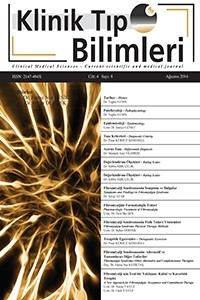Bruxism, EEG-EMG İlişkisi
Bruxism, EEG, EMG, Sinyal İşleme, ÖzBruxism
Bruxism, EEG-EMG Relationship
___
- Kaynaklar 1.T. Kato, “Overview of sleepbruxism: historyand on tthewayweare”,2nd WASM World Congress, Bangkok, 4–8 February 2007 / Sleep-Medicine 8 Suppl. 1 (2007) S11–S47 2.Martinaz A. ve arkadaşları, ”Polymeric Piezoelectric Sensors and Re-mote Communication for Detection of Bruxism”, IndustrialTechnology(ICIT), 2010 IEEE International Conference on, 268-273, 2010 3.Toledano M. ve arkadaşları,” Effect of in vitrochewingandbruxis-mevents on remineralization, at theres in dentin interface”, Journalof Biomechanics, Vol:48, Sayfa:14-21, 2015 4. Minakuchi H. ve arkadaşları, Multiple sleep bruxism data collec-tedusing a self-contained EMG detector/analyzersystem in asymp-tomatichealthysubjects” SleepBreath, Vol:16, Sayfa: 1069–1072,2012 5.Xiao D. ve Ark. ,”Classification of motor imagery EEG signalsba-sed on energyentropy”, 2009 International Symposium on IntelligentUbiquitous Computing and Education, 61-64 6.Başçıl.M.S.2014,”Beyinde Üretilen Yöne Bağlı EEG SinyallerininÖznitelik Çıkarımı Yardımıyla Sınıflandırılması”, Doktora Tezi,Sakarya Üniversitesi Fen Bilimleri Enstitüsü. 7.Minakuchi H. ve arkadaşları, “Multiple sleep bruxism data collectedusing a self-contained EMG detector/analyzer system in asymptoma-tic healthy subjects” SleepBreath, Vol:16, Sayfa: 1069–1072, 2012 8.Thorpy M.J ve arkadaşları, “Classification of Sleep Disorders”, Neu-rotherapeutics, Vol: 9 , Sayfa: 687–701, 2012 9.Tomoeda K. ve arkadaşları, “Sleep bruxism needs deep sleep sta-ges and seems to reduce psychological stress”, J. Stomat. Occ.Med,Vol:4, Sayfa:54-58, 2011 10.Zaag J. ve arkadaşları,” Time-llinked concurrence of sleep bruxism,periodic limb movements, and EEG arousals in sleep bruxers andhealthy controls”, Clin Oral Invest,Vol:18,Sayfa:507-513, 2014 11.Deregibus A. ve arkadaşları, “Reliability of a portable device for thedetection of sleep bruxism”, Clin Oral Invest, Vol: 18, Sayfa:2037–2043, 2014 12.Gorur K.ve Ark.,”Literatür Özeti: Bruxism”, Electronic Letters onScience&Engineering 1-2016,11-16 13.https://www.medicalmarijuana.com/medical-marijuana-treatments-cannabis-uses/ cannabinoids- alleviate-symptoms-of-bruxism/,(Son Erişim Tarihi: 27.02.2017 ) 14.İto S.ve Ark.,” A Feature Extraction of the EEG DuringListening-tothe Music Using the Factor Analysis and Neural Networks”,Pro-ceedings of the International Joint Conference on Neural Networks,2003.2263-2267. 15.Adeli H.ve Ark.,” A Wavelet-Chaos Methodology for Analysis of EEG-sand EEG Sub-bands to Detect Seizure and Epilepsy'', IEEE Trans-caitons on Biomedical Engineering,Vol. 54, NO. 2, 2007 16.A.Lebhedev. M. ve Ark.,” Brain–machine interfaces: past, presentand future”,Trends in Neurosciences Vol.29 No.9, 536-546 17.Janet R.R.E.ve Ark.,”Bio-signal based control in assistive robots: asurvey”, Digital Communications and Networks (2015) 1, 85–101 18.Deregibus A.ve Ark.,”Reliability of a portable device for the detec-tion of sleepbruxism”,Clin Oral Invest (2014) 18:2037–2043 19. O.Regan S.ve Ark.,”Multimodal detection of head-movement artefactsin EEG”,Journal of Neuroscience Methods 218 (2013),110– 120 20.Sammaiah A. ve Ark.,” On The Performance of WaveletTransformImproving Eyeblink Detections for BCI ”, Proceedings of Icetect,2011,800-804 21.Vuˇckovi´ A.ve Ark.,” A two-stagefour-class BCI based on imaginary-movements of theleftandtherightwrist”,MedicalEngineering&Physics34 (2012) 964– 971 22. Wu S.L.ve Ark.ve Ark.,”Fuzzy Integral with Particle Swarm Optimi-zation for a Motor-Imagery-based Brain-ComputerInterface”,IEEETransactions on Fuzzy Systems, 2016, 1-8 23. Salih Güneş, Kemal Polat, Mehmet Dursun , ŞebnemYosunkaya , “EEG, EOG ve Çene EMG Sinyallerinin Zaman Domeni Özellikle-rinin Uyku Evreleri ile İlişkisinin İncelenmesi” BİYOMUT-2009, İz-mir (2009). 24. Scholz M. 2006 ““Approaches to analyse and interpret biologicalprofile data”, Ph.D. thesis, University of Potsdam, Germany 25.http://docs.opencv.org/2.4/modules/ml/doc/neural_networks.html(SonErişim Tarihi : 27.02.2017) 26. Stock P. ve arkadaşları, “Monitoringbruxism”, Med. &Biol. Eng.&Comput,Vol :21,Sayfa: 295-300, 1983 27. Ruhland J.ve arkadaşları,”Acquisition and analysis of electromyog-ramsof thehuman mas-seter muscle”, ieeeengineering inmedicine&biologysociety 10th annual international conference,Sayfa:1-2, 1988 28. P.A ve arkadaşları, “An example of System on Chip design for bio-medical applications: bruxism therapy”, Instrumentation and Mea-surement Technology Conference - IMTC 2007 Warsaw, Poland,Say-fa:1-3, 2013 29. Morgado ve P. ve arkadaşları,”Instrumented Splint for the Diagno-sis of Bruxism”, First International Conference on Biomedical Elect-ronics and Devices, Portugal, Sayfa: 216-221, 2008 30.Martinaz A. ve arkadaşları, ”Polymeric Piezo electric Sensors and Re-mote Communication for Detection of Bruxism”, IndustrialTechnology(ICIT), 2010 IEEE International Conference on, 268-273, 2010 31. Kim H.J. ve arkadaşları, ” Development of bite guardforwirelessmo-nitoring of bruxism using pressure-sensitive polymer”, Internatio-nal Conference on Body Sensor Networks, Sayfa: 109-116, 2010 32.Aqueveque P. ve arkadaşları, “Electrical Stimulation Device as Pos-sible Treatment for Nocturnal Bruxism: Preliminary results”, 35thAnnual International Conference of the IEEE EMBS, Japan, Sayfa:3571-3573, 2013 33.Castroflorio T. ve arkadaşları, “Use of Electromyographic and Elect-rocardiographic Signals to Detect Sleep Bruxism Episodes in a Na-tural Environment”, IEEE Journal Of Biomedical and Health Infor-matics, Vol. 17, Sayfa: 994-1001, 2013 34.Jirakittayakom N. ve arkadaşları,” An EMG Instrument Designedfor Bruxism Detection on MasseterMuscle”, Biomedical EngineeringInternational Conference (BMEiCON), Sayfa: 1-5, 2014 35.Peña-Cortés C.A. ve arkadaşları, Warning and Rehabilitation SystemUsing Brain ComputerInterface (BCI) in Cases of Bruxism”,Ing. Univ.Bogotá (Colombia), Volo:18 1,Sayfa: 177-193, 2014 36.S Kostka P. ve Ark., “Multi-sources data analysis with sympatho vagalbalance estimation toward early bruxisme pisodes detection.”, Conf ProcIEEE Eng Med Biol Soc, 2015 , 6010 6013
- ISSN: 2147-494X
- Başlangıç: 2013
- Yayıncı: Selen Medya Yayıncılık Tanıtım ve Organizasyon Hizmetleri
Topikal Olarak Yumurta Beyazı Uygulanması Sonrasında Anafilaksi: Vaka Takdimi
Mum Sönsün Akciğerlerin Sönmesin; KOAH Farkındalık Çalışması
Polisomnografi Cihazına Alternatif Sistem Tasarımları için Öneriler
Arş. Gör. Muhammed Kürşad UÇAR
Chiliaditi Sendromu; Bir Olgu Nedeniyle
İlginç Bir Yabancı Cisim Aspirasyonu Olgusu
Diş Çekimi Sonrasında Gelişen Pnömomediastinum
